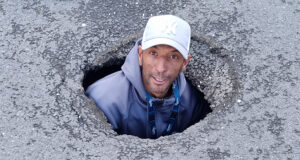“The sewer is the conscience of the city,” Victor Hugo wrote in Les Misérables. “The mass of filth has this in its favour: that it is not a liar.” I thought about that quote recently, when I heard how Britain’s water companies are planning to improve the country’s rampantly polluting sewage network. As tales abound of quaint Cumbria villages confined to their cottages by foul-smelling air and idyllic Cornish coves turning brown, water companies have pledged to spend an additional £10 billion between now and 2030. But rather than take on this investment themselves, or cut their plentiful dividends, the industry intends to pay for it by hiking our bills. Even then, they admitted, the investment is only likely to cut spills by half compared to 2020. As solutions go it seems, well, pretty shitty.
Britain’s waters are in a foul state. Official statistics show that there was an average of 825 sewage spills a day last year — including in the Environment Secretary’s own Suffolk constituency, where the water contains levels of e. coli more than 20 times the limit for bathing. In England, just 14% of rivers are rated ecologically “good”. In January, an NHS worker caught hepatitis while wild swimming, and last summer, dozens of beaches in England were closed due to toxic waste warnings.
The result is that the seemingly old-fashioned issue of sanitation — a problem most of us thought we’d solved around the same time as cholera — has once again become a political flashpoint. Half the British public now see protecting rivers as an important voting issue. In the May local elections, both the Liberal Democrats and Greens specifically targeted sewage as a swing issue — and saw their biggest gains in years. The Conservative seats newly up for by-elections should take note: Nadine Dorries’ former constituency of Mid Bedfordshire, for one, is currently in uproar at the sorry state of the river Ouse.
This is part of a wider trend: the environment is now regularly among the top four issues most important to the electorate — beating issues such as crime or childcare. It is even more of a focus in Conservative-held swing seats. And there’s a reason why sewage inspires such strong emotions — beyond the fact that it’s ruined the wild swimming trend. The scandal is in many ways a perfect microcosm of Britain’s political woes of the last decade: austerity, failed privatisation, corporate greed, climate apathy. After all, what good is a government if it can’t keep our shit out of our streams?
If you want to understand how this country’s waters got into such a mess, an obvious place to start is in 2010, with the coalition government. Its austerity policies slashed spending ringfenced for environmental protection by 80%, gutting the Environmental Agency’s ability to monitor our waters and, crucially, enforce punitive measures against polluters. It’s hardly surprising that, since then, sewage spill events into British rivers have doubled.
But one could go back even further. It was Margaret Thatcher’s government that, in 1989, privatised water utilities in England — making it the only country in the world to do so. The water companies were granted regional monopolies, debt-free, the argument being that they could run the system more competitively than the state could. In reality, many water companies have spent the decades since loading themselves with debt, deploying increasingly byzantine financial engineering to avoid corporation tax, and paying billions to shareholders and millions to their own executives — all the while under-investing in infrastructure and hiking prices for customers at rates considerably above inflation. Handed a money tap, they simply turned the spigot.
But if you want to get to the real heart of our sewage crisis, it makes sense to go back even further, to the summer of 1858, and the now infamous “Great Stink”. One of the things that period dramas never capture about Victorian England is the stench. It’s hard to imagine: tanneries filled the air with the scent of urine-soaked hides, and soap-makers with the smell of boiling bones. Carriages clogged the roads, leaving them caked in horse manure. But worst of all would have been the smell of human shit.
Before the widespread adoption of sewers, people used privies — holes that emptied into a cesspit. For centuries those cesspits were cleaned out by nightsoil men, who would come by and, for a small fee, dig out and cart your waste away to farms on the outskirts of the city to be used as fertiliser. In the 1840s, led by sanitary reformers such as Edwin Chadwick, the British government passed a series of measures to try to clean up the capital. Among their reforms: mandating the connection of cesspits to the city’s sewers.
It was a deadly mistake. Rather than clear the air as Chadwick had hoped, the solution channelled an ever-greater deluge of foulness into the Thames. By the 1850s, the river was unimaginably polluted. Dickens called it a “deadly sewer”, Benjamin Disraeli a “stygian pool, reeking with ineffable and intolerable horrors”. In the summer of 1858, London boiled. The water levels in the river fell, leaving the waste within slathered up the banks. The smell fell foul across the city; there were reports of people feeling sick from miles away. Parliament ordered the curtains doused in lime chloride to mask the stench, with little effect.
The Great Stink led Westminster’s flailing political classes to finally act. They appointed the Joseph Bazalgette — one of the great British engineers of his time — to design a massive new sewage system for London. Bazalgette’s plan was astonishing in scope: it resulted in the laying of 720km of new sewer lines and the creation of the Victoria and Albert embankments, reshaping the city and its connection to the Thames. The resulting reduction in exposure to unclean water likely prevented millions of deaths; it’s thought that the introduction of sanitation in the 19th century added 20 years to the average human lifespan.
But Bazalgette’s design had a significant flaw; it was a combined sewer — that is, the main underground pipes were designed to carry both wastewater from buildings and rainwater collected by the city’s drains, to help dilute and flush out the system. During unusually heavy rainfall, they would flood; with such instances in mind, the sewers were designed with outlet valves called Combined Sewer Overflows, which would expel excess flow directly into waterways, untreated. Here is where our current sewage crisis stems from.
When Bazalgette designed London’s sewers, overflows were supposed to be a rare event. But various factors have conspired to make them commonplace. One is the all-engulfing expansion of concrete: new roads, pavements, and building developments block rainwater from entering natural soakaways — trees, soils, wetlands — that would otherwise absorb it. Another factor, inevitably, is climate change, which increased the occurrence and intensity of storms — and therefore flooding.
Today, there are around 100,000km of combined sewers in England alone, and around 15,000 overflows. Modern sanitary engineers hate them, but because so many of the central “hub” sewers are combined, introducing new models often doesn’t make a difference. To prevent spills, water utilities have periodically built storm overflow tanks, designed to hold excess sewage until it can be treated. But due to systemic under-investment by water companies, there is at present simply not enough capacity to store it all. For my book, Wasteland, I visited Mogden sewage works in London, which serves an estimated two million people: it has a series of storm tanks installed, and yet in 2020 alone it released enough sewage into the Thames to fill 2,768 Olympic swimming pools.
Water companies often use their ancient infrastructure as an excuse for not solving their pollution problem. It’s certainly true that replacing our combined system would be a Bazalgettian feat; a government-commissioned report, published in 2021, estimated that eliminating storm overflows in the UK would cost up to £600 billion, and increase household bills by up to £999 a year. (Not that we would have to replace the whole system to make the situation more bearable.) It would also do nothing to solve the other primary culprit behind our spoiled waters, the rampant phosphate pollution by industrial farms. The current plan, in London at least, is to divert the existing combined sewers into something even bigger: the £5 billion Tideway Tunnel currently being dug under the Thames. Thames Water estimates that when the “super sewer” is completed in 2024, 95% of raw sewage that pollutes the river today will no longer flow into it.
But the fact is, just continuously expanding the old system isn’t going to work. This is one of the central dilemmas presented by climate change: do we press ahead with novel but potentially expensive technological solutions, or do we look back, and find inspiration in the natural world? China, for example, has met the sewage challenge by embracing so-called “sponge cities”, in which natural soakaways, permeable pavements, and wetlands are being built into city planning in order to soak up storm water and prevent flooding.
But swales and reed beds are not going to replace our traditional sewage infrastructure any time soon. Solving this problem can’t wait. With summer droughts becoming more common and storms more intense, protecting our water supply is only becoming more vital. Whoever wants to win the next election is going to need to convince the public they can turn the situation around, and fast.
Disclaimer
Some of the posts we share are controversial and we do not necessarily agree with them in the whole extend. Sometimes we agree with the content or part of it but we do not agree with the narration or language. Nevertheless we find them somehow interesting, valuable and/or informative or we share them, because we strongly believe in freedom of speech, free press and journalism. We strongly encourage you to have a critical approach to all the content, do your own research and analysis to build your own opinion.
We would be glad to have your feedback.
Source: UnHerd Read the original article here: https://unherd.com/




